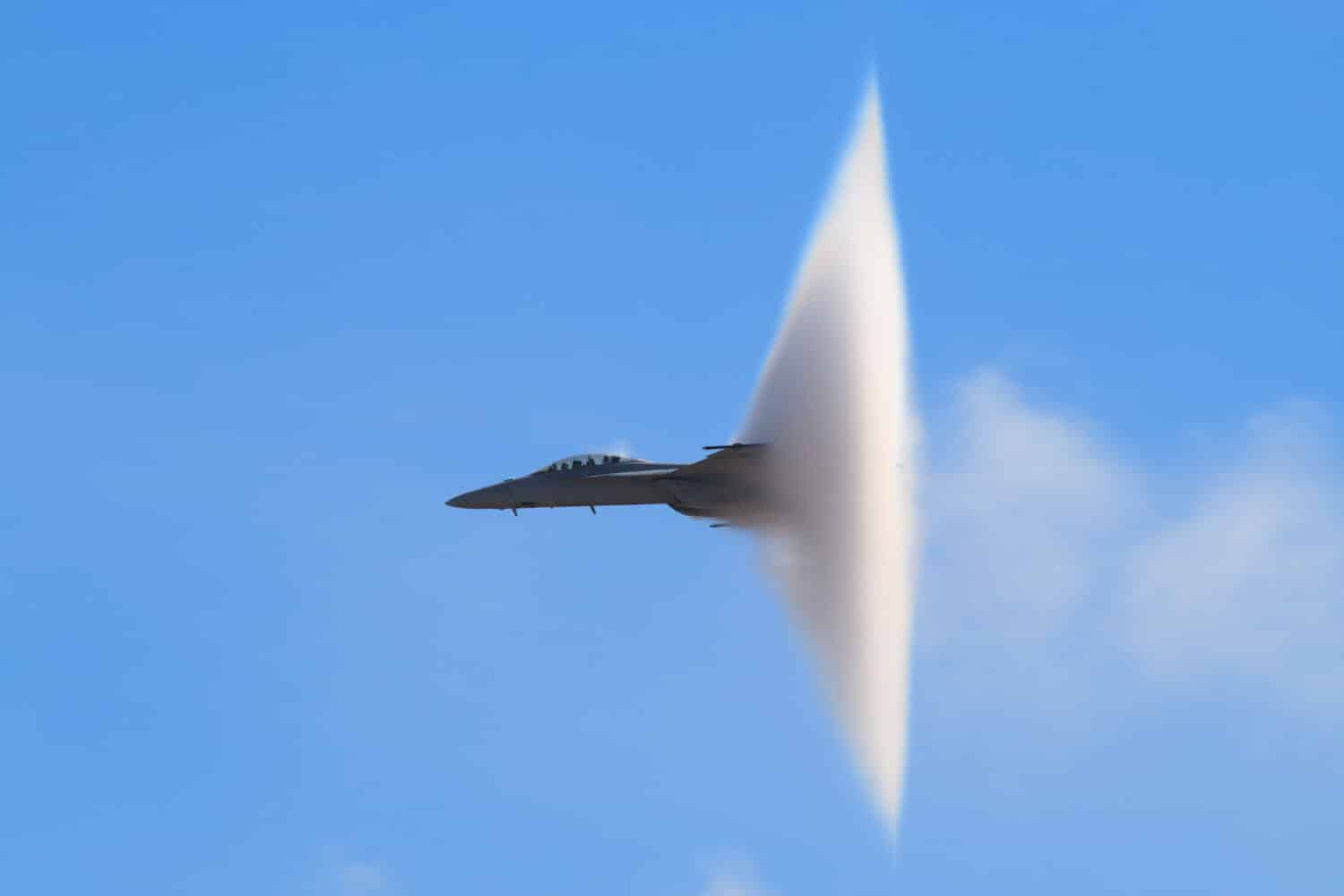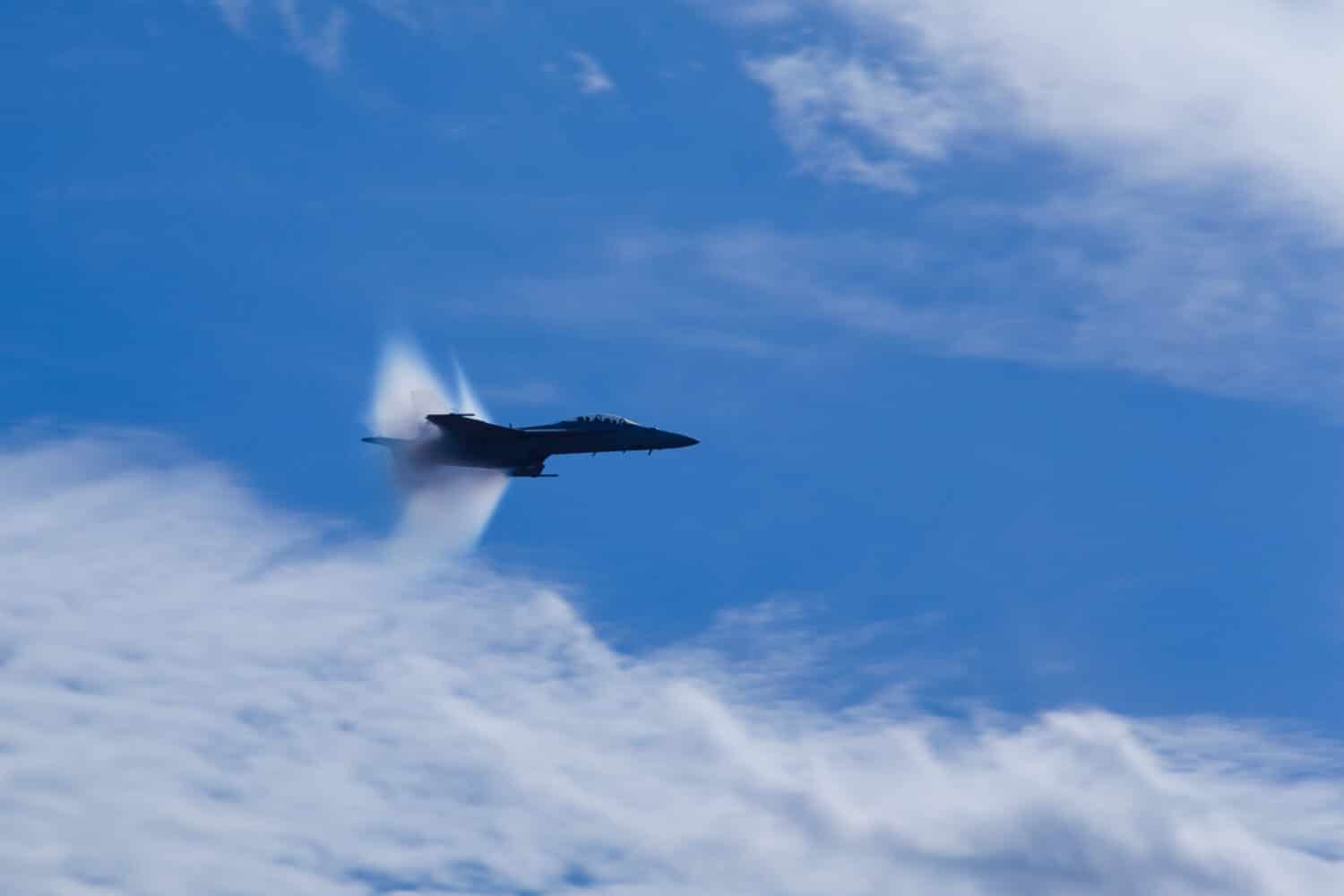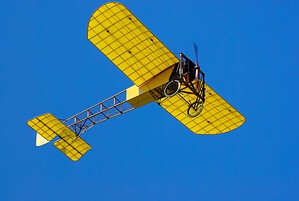
Aircraft that fly faster than Mach 1 need a specialized design to handle the turbulence.
©SVSimagery/Shutterstock.com
If you were to ask someone who was passing you by at Mach 1 how fast they were going, they wouldn’t answer. Because they wouldn’t hear you. To travel at Mach 1 is to travel at the speed of sound, so your question wouldn’t be able to catch up.
So how fast is the speed of sound, then? Answering that question reveals some pretty interesting truths about the physical world, and in particular, about how sound works.
What Even is Sound?
To really understand what Mach 1 means, it helps to understand the phenomenon that it represents. What we call sound is a mechanical disturbance that passes through layers of air. Sound originates when something starts vibrating, whether it’s the head of a drum whacked by a drumstick, or your cat’s vocal cords as it meows to be fed. That vibration pushes against the nearby air, which pushes against the air near it, and so on. When the resulting wave of pressure reaches your ear, your brain interprets it as sound.

Hear this: What we perceive as sound is the effect of air vibrating against our eardrums.
©Peakstock/Shutterstock.com
Since sound travels through a physical medium, its speed is affected by that medium’s physical properties. In air, for example, a sound wave is transmitted by gas molecules banging into each other. The warmer the air, the faster the molecules are moving, and the faster the speed of sound. At a temperature of 32 degrees F, sound travels at about 741 miles per hour. At 85 degrees F, the speed of sound is about 780 mph. You can determine the speed of sound in air at various temperatures for yourself using the National Weather Service Speed of Sound Calculator.
Sound travels at different speeds in different types of gasses. For example, the speed of sound at 32 degrees F is 707 mph in pure oxygen and 2,158 mph in helium. It also moves at different speeds in various liquids and solids: 3,241 mph in salt water at 32 degrees, for example, and 11,250 mph in rolled aluminum.
What Does Mach 1 Mean?
So now that you know there is no absolute “speed of sound.” This means that “Mach 1” isn’t an absolute speed, but a relative one. “Mach 1” means moving at the speed of sound, whatever that is according to local conditions. So for an airplane traveling in air that’s at 85 degrees F, Mach 1 would be 780 mph. For another plane that’s flying in 32-degree air, Mach 1 is 741 mph. Some weird science-fictiony object flying through a helium atmosphere would need to top 2,000 mph to hit Mach 1. The Mach number is calculated by dividing an object’s current speed by the speed of sound in that location. So an object flying at twice the speed of sound is Mach 2. Three times is Mach 3, and so on.
The Mach numbering system takes its name from Austrian physicist Earnst Mach, who established the concept in 1887. It wouldn’t be until 1947 that the first human being traveled at Mach 1. That was the year U.S. Air Force pilot Chuck Yeager, flying solo for the 8th test flight of an experimental aircraft, reached a speed of Mach 1.06. By 1959, subsequent aircraft were able to reach Mach 5.
What Happens When You Break the Sound Barrier?

Flying faster than Mach 1 creates shock waves called sonic booms.
©Chris K Horne/Shutterstock.com
The Yeager plane wasn’t the first man-made object to travel faster than sound. Cannonballs did it, so did bullets. And even the crack of a bullwhip is caused by the tip moving that fast. But the difficulties of creating an aircraft that could travel so fast led to the idea of a metaphorical “sound barrier” that had to be pushed through. What actually happens is that as an aircraft approaches Mach 1, the pressure waves that it creates can’t outrace the plane itself. This causes drag and shock waves on the aircraft, making it hard to control. Yeager’s plane had to be modified to counteract this. When a flying object reaches and exceeds Mach 1, the pressure waves combine into shock waves that are heard as explosion-like sonic booms. A craft flying faster than the speed of sound generates multiple sonic booms along its flight path.
An object that moves slower than the speed of sound is called subsonic. Flying at or near the speed of sound is defined as transonic flight. Speeds between Mach 1 and Mach 5 are called supersonic. And speeds beyond that—the space shuttle, for example, re-enters the earth’s atmosphere at Mach 25—are designated as hypersonic.
Some objects that have been propelled to Mach 1 and beyond include:
Thrust SSC, the first car to break the sound barrier: 763 mph, Mach 1 (via the Guinness Book of World Records)
SR-71 Blackbird aircraft, 2000+ mph, Mach 3
Air Force Rocket Sled: 6,433 mph, Mach 8.35
NASA X-43A Unmanned hypersonic aircraft: 7,000 mph, Mach 9
The photo featured at the top of this post is © IanMairPhoto/Shutterstock.com
Thank you for reading! Have some feedback for us? Contact the AZ Animals editorial team.






